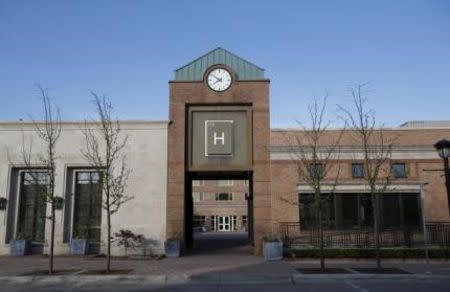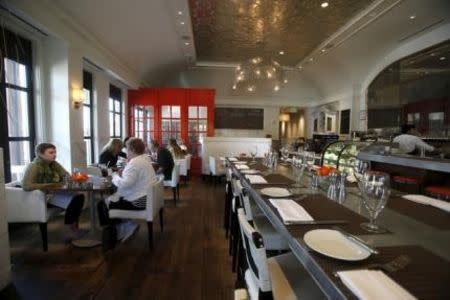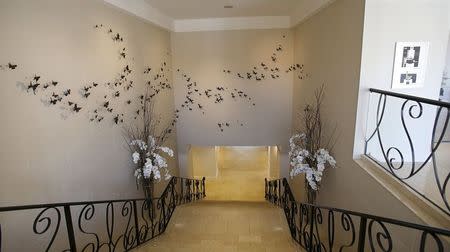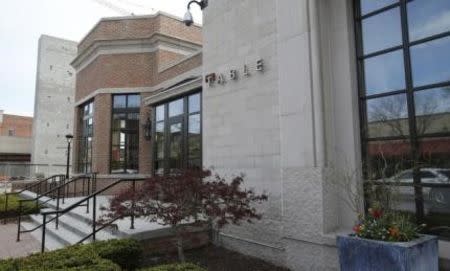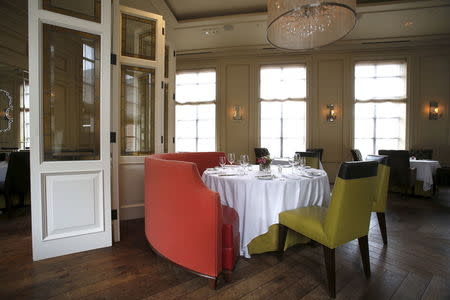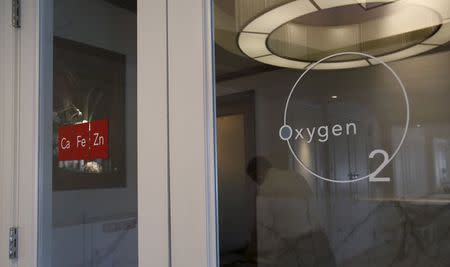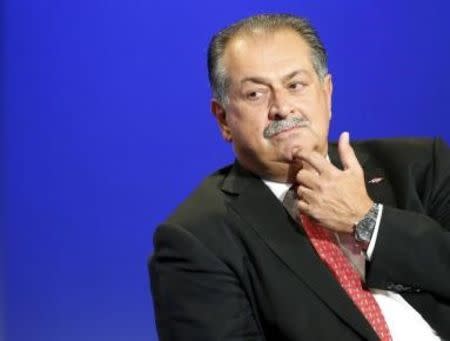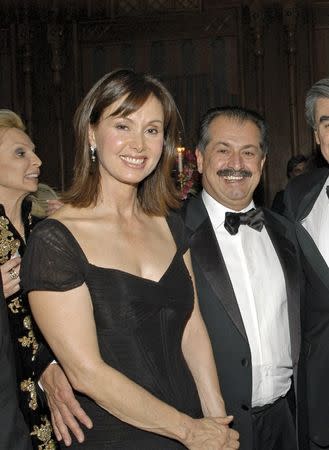Special Report: As hotel project broke budget, insiders pointed to role of CEO's wife
By Brian Grow and Joshua Schneyer MIDLAND, Michigan (Reuters) - When Dow Chemical Co began renovating the hotel it owns here, the industrial giant spared little expense. From 2006 through 2008, Dow turned the former Ashman Court Hotel into a luxury destination. Out went the tile in the lobby. In the rebranded H Hotel, guests walk on Crema Marfil marble from southeast Spain. Also gone are the old restaurant and its $9.95 lunch buffet with dessert bar. Now the hotel boasts a fine-dining establishment where, planning documents show, prices would be “2 notches up” from what the market will bear. The H has a private dining room with bullet-proof glass, where CEO Andrew Liveris, a regular visitor to the White House, can entertain VIPs. By most accounts, the H Hotel is a source of pride here in Dow’s hometown of Midland, population 42,000. The remodeling didn’t go off without a hitch, though. At completion, it exceeded its $25 million budget by an estimated $13 million. This year, the company settled a lawsuit by one of its former investigators, Kimberly Wood. She alleged she was fired years after she investigated the H Hotel and other spending issues relating to CEO Liveris, according to documents filed in her case. Wood was assigned to scrutinize the renovation after a senior manager complained about the role of a person who figured large in the project, but was neither an employee of Dow nor its contractors: the wife of Andrew Liveris, Dow’s chief executive. In a whistleblower-retaliation complaint filed last year, Wood claimed that the “H Hotel cost overrun was the direct result of the meddling by the CEO’s wife, Paula Liveris.” "MISPERCEPTIONS" BY EMPLOYEES That view is rejected by Dow and by an outside law firm it hired to examine the matter in late 2009. After a three-week inquiry, the lawyers cleared the company of violating any of its own policies. The firm disputed the notion that Paula Liveris exercised undue influence on spending decisions. Rather, its report concluded there were “misperceptions by some Dow employees about the role and authority of Ms. Liveris.” Other project participants, including the chief architect, offer a different perspective. “Once Paula became involved, the budget was taken off the table and we didn’t really talk about it anymore,” said David Greusel, a former principal at a unit of global architecture firm HOK, which headed up the renovation. “There was clearly a difference in the design direction. Paula Liveris definitely made choices that we had not made at the outset.” A former Dow executive involved in the project kept for his own use a timeline that he said he created to chart cost increases. By his accounting, decisions advocated by Paula Liveris and a friend who assisted her, local artist Maria “Mica” Jones, led to cost increases totaling about $5.8 million. Dow’s former top auditor, Doug Anderson, testified in Wood’s wrongful-termination lawsuit against the company that he grew concerned about the hotel project in 2009. That year, Wood and a supervisor reported at the time, a Dow manager involved in the hotel came forward to voice concern about the role Paula Liveris had played. He claimed that two employees had been pulled off the project and later left Dow, Wood reported, one after trying to limit the role of Paula Liveris and the other for proving “ineffective” in dealing with her. Dow’s external report concluded that no employees were retaliated against. One of the two employees removed from the project provided Reuters with a statement saying he retired voluntarily. The external report also said that “Ms. Liveris did not exercise any authority, implied or actual, over the project budget, and that any perception to the contrary is erroneous and is not supported by the evidence.” “COMPLETELY FALSE” The H project provides insight into the way the Dow CEO’s personal life has intersected with his role as head of the company. Liveris, 61 years old, has led Dow for 11 years. Cost overruns are common in construction, and the H’s were readily absorbed by Dow, with $58 billion in annual revenue in 2014. Still, governance specialists said it is rare for the CEO of a large publicly traded company to let a spouse play a prominent part in a deca-million-dollar capital project. “I can’t think of a similar example,” said Robert Daines, co-director of the Rock Center on Corporate Governance at Stanford University. “The governance concern is whether she was picked for her expertise, or as sort of a perk for the CEO to give his wife a position of prominence.” Former auditor Anderson said in his deposition that he believed the presence of Paula Liveris put other participants in a predicament. “Who is going to tell the CEO’s wife you don’t belong here, get out of here, I’m not going to do what you say, when by all appearances and everything else, she’s there with the blessing of the CEO?” he testified. Anderson, who left Dow in 2013, said he was barred by a confidentiality agreement from commenting about the company. Dow says the company has a tradition of inviting executive spouses to pitch in on community projects. Members of the planning group that handled the renovation say Paula Liveris herself never signed off on expenditures. Those were submitted by the project team and approved by David Kepler, the Dow executive who was supervising the project. Kepler, now retired, told Reuters that blame for going over budget rested with others, including two of his subordinates and outside architects. Any notion that “there was significant overspending and that it was due to interior design choices made by Paula Liveris and Mica Jones is completely false,” Kepler said. Documents detailing Dow’s handling of the renovation are among thousands of pages of records subpoenaed by the U.S. Securities and Exchange Commission. Reuters reported in June that the SEC is investigating allegations that CEO Liveris may have misused company funds for personal benefit. Previously, Reuters reported about disputes Liveris had with Anderson and Wood over his spending, including Super Bowl getaways with family and friends. Dow disclosed in 2011 that Liveris reimbursed the company $719,923 for expenses described as “not primarily business related,” without detailing them. According to two people familiar with the matter, the SEC has sought information regarding the CEO’s spending. It has also inquired in recent months about the terms of confidential severance agreements that Dow has required former employees to sign. The agency, the people said, has asked whether these agreements contain provisions which could impede potential whistleblowers from bringing concerns to the SEC. Dow declined to comment on the SEC investigation. ADVISORY TEAM About 130 miles northwest of Detroit, Midland is a prosperous community, thanks primarily to Dow, its largest employer. But the city is served mainly by chain hotels and casual restaurants. Andrew and Paula Liveris, according to planning documents and interviews, wanted to create a first-class facility in line with Dow’s global stature and the couple’s exacting standards. The H would aid in revitalizing downtown Midland, wooing hires to the area and entertaining Dow clients and employees from around the world. The renovation also would accommodate a leadership training facility Dow wanted. That facility now occupies a wing of the H. The initial scope was relatively modest. After architects were solicited to bid in January 2006, the estimated cost was less than $16 million. The proposal focused on Dow’s training academy and one “fine dining” restaurant. Ahead of the first design meeting in February 2006, Liveris told project managers that his wife would act as his representative. Her appointment wasn’t the CEO’s idea, according to the outside attorney’s review. It was suggested by Dow’s former head of human resources, Julie Fasone-Holder, who felt Liveris would be too busy to keep close watch over the project. In his stead, she recommended that Paula Liveris volunteer her time and talents. The CEO endorsed the idea. A friend of the couple, Mica Jones, described by Dow as a “well-known local artist,” also joined the effort. Paula Liveris attended the initial design session for the H in February 2006, meeting minutes show. In one early 2006 memo, she and Jones are listed as members of the “Design Advisory Team.” Kepler told top architects and designers “to feed design information to Paula and Mica who will provide their perspective and counsel,” according to minutes from a June meeting. “Paula wants two to three options for the restaurant along the lines of the best restaurants from Chicago or New York.” A NEW DESIGNER That summer, Paula Liveris and Mica Jones recommended hiring a new design architect, according to Greusel: Mark Johnson, based in suburban Detroit. “Once Mark Johnson was on the job, the design just became very different,” said Greusel, the lead architect. “To my impressions and tastes, we had gone up a notch from upscale. And it still went higher.” The hiring of Johnson alone, according to the project timeline kept by the former Dow executive, cost an estimated $300,000 more in design fees. Johnson took on the key role of designing the restaurants and executive dining areas, “per Paula Liveris’s request,” the former executive wrote in an August 2006 entry in his timeline. The former executive provided the information to Reuters on condition of anonymity, saying the severance agreement he signed contains a clause that bars him from discussing his experience at Dow. Johnson declined to comment. Dow says it concluded that more design expertise was needed because HOK’s team specialized in sports facilities. By late 2006, the project was bigger and fancier. The finishes would be luxe, “obtained from around the world,” says the website of a construction firm that helped run the project. “Millwork species include cherry, bamboo, walnut, rift white oak (some of which was fumed), maple, makore fiddleback and wenge.” Jonathan Schiller, a lawyer for Dow, responded to Reuters questions about the added luxuries by saying the renovation balanced high-end items with frugal materials, including “the pervasive use of cement floors, pavers from Michigan, and normal carpeting.” TRIP TO THE MALDIVES Costs swelled. By July 2007, the H’s projected budget rose from $25 million to $30 million. Part of that increase, the Dow executive who kept the private timeline wrote, was $2.5 million “for selecting higher end products by Mrs. Liveris and Jones.” The budget rose again in December – to $33 million. In the timeline, the former Dow executive attributes that bump to $3 million for a ballroom and public corridors. The designs by another company Dow hired, the Anderson/Miller firm, “used higher end material specified by Mrs. Liveris and Jones,” the former Dow executive wrote in his private timeline. Anderson/Miller declined to comment. The CEO’s wife held great sway over many details, say six people who worked on the project. For instance, an early planning document called for the lobby and vestibule to be floored in limestone tile and carpet. Paula Liveris wanted marble, say three participants. Project and construction managers warned that the hard polished marble could pose a risk of guests slipping. The marble prevailed. Dow spokeswoman Rebecca Bentley said “the marble used in the H Hotel lobby meets all applicable building codes,” and she cited the hotel's “excellent safety record.” As the renovation wound down in late 2008, Dow incurred at least one more expense. Jones received “two first class tickets to anywhere in the world,” according to a report written by Dow’s external lawyers. Jones and her husband ended up going to the Maldives, the Indian Ocean archipelago known for its beaches and lagoons. Kepler said the gift was his idea, and he found it appropriate, given “the time Mica spent on the project.” The cost was at least $67,000: about $40,000 for first-class airfare, plus $27,000 to cover the couple’s income taxes. In an interview, Kepler said he couldn’t recall the final cost of the project. Dow spokeswoman Bentley didn’t provide an exact figure. But the internal report written by former fraud investigator Wood and her supervisor, dated Nov. 17, 2009 and marked “preliminary,” says that the project went $13 million over budget. Kepler said around “90 percent” of the increases stemmed from structural alterations unrelated to interior design. The CEO’s wife and her friend had no impact on those costs, he said. CORKAGE FEE Located on Main Street, the chemical company’s hotel has sleek white interiors and eating establishments whose names evoke the Periodic Table of Elements. There’s Bar Oxygen, Café Zinc, and Table – its main restaurant. Table’s menu is pricey for a small city in the Midwest: The Premium Black Angus Petite Filet goes for $40. Index cards from planning meetings that Paula Liveris attended show the thinking that helped shape the restaurant. One mentions New York’s renowned French restaurant Le Bernardin – noting that “Andrew likes the atmosphere.” The CEO became an important customer. After Table opened, according to a separate June 14, 2010 report by Wood, Dow sent to the H two cases of wine the company had purchased. It was Penfold’s Grange Shiraz, valued at $354 a bottle, and Liveris “wanted to be served” the wine at the hotel’s restaurants, the report said. Hotel managers thought wait staff would lose out on tips if the CEO drank from this stock. So, they imposed a corkage fee of $30 a bottle. When Liveris was told by email, “he wrote that the fee was ‘outrageous,’” Wood reported. The hotel cut the “personal-use fee” for Liveris to $15 a bottle. Dow declined to comment. In many ways, Table was the success its planners envisioned. Reviews on websites such as OpenTable rate the restaurant highly. But Table struggled financially, too. The H’s former general manager, Lynne Luongo, said Table didn’t turn a profit “or struggled to break even” during her tenure. Kepler said the H is “meeting its revenue targets ahead of plan.” “TIME FOR RETIREMENT” In the spring of 2008, Dow began assigning blame for the busted budget. On May 22, 2008, according to the external report Dow later commissioned, Kepler told Liveris that an extra $15 million to $18 million was needed to finish the hotel. When Liveris asked what went wrong, Kepler replied that “there is some significant coaching still needed on some of the folks involved,” and then wrote, “I will take accountability.” While Kepler kept his job, two of his subordinates on the project didn’t: Mike Hayes, a Dow vice president supervising the project, and Peyman Zand, a Dow director handling construction. Both worked closely with Paula Liveris. On May 24, according to Wood, Liveris messaged Kepler and two other executives that it was “time for retirement” for Hayes, without saying why. In the email, subject-lined “Hayes,” Liveris suggested another executive who could take over the H project. The email is cited in a complaint Wood filed with the U.S. Occupational Safety and Health Administration. The next day, Kepler forwarded the CEO’s email to Dow’s general counsel and its HR chief and wrote: “I agree with the position to have (Hayes) retire … I have a call with Andrew on Tuesday, let me talk to him on this subject and then we can develop a plan.” Asked about the emails, Kepler said he couldn’t recall them. SAYING "NO" A week later, Dow’s external report shows, Kepler informed Liveris that he was removing Zand and Hayes from the project. Hayes decided to retire voluntarily and amicably about a month after the email exchange, he wrote in a statement made in response to Wood’s OSHA complaint. Hayes also wrote that Paula Liveris bore no responsibility for cost overruns. Hayes shared his statement with Reuters, but declined to talk for this article. Zand was moved to a new job, according to the external report commissioned by Dow. His new boss found Zand “unable to perform,” according to the external report, and Dow eliminated his position later that fall. The report said Zand made no claim of retaliation. Dow’s internal investigation into the hotel matter began after Zand’s successor on the H project raised concerns, according to the report Wood co-authored. She and her supervisor wrote that the successor, Paul De Pree, “said he had accepted the position on one condition – that Kepler back him when he said no to Paula.” According to their report, Hayes told Paula Liveris in April 2008 that she could continue working on areas such as the hotel’s restaurants, but not on other parts of the hotel. De Pree, Wood and her boss wrote, “stated that Mike Hayes told him that he said ‘no’ to Paula and this is why he was no longer in that position.” De Pree also claimed that Zand became “ineffective in dealing with Paula and Mica and was terminated because the project was out of control,” Wood reported. LAWYER'S RECOMMENDATION Dow, in its response to Wood’s OSHA complaint, said that nothing in the May 2008 email chain about Mike Hayes “links Mr. Hayes’s fate to, or even references, any disagreements with Ms. Liveris regarding the H Hotel.” Hayes later sent CEO Liveris an email of thanks for handling his retirement “in such a thoughtful manner.” He added: “I will depart as one of the strongest ambassadors for the company that you could ever hope to have.” Hayes provided the email to Reuters. De Pree still works at Dow and could not be reached for comment. Zand, asked to comment, said he signed a confidentiality agreement and has “moved on” from Dow. In their report, Wood and her boss recommended that Dow investigate further. The next month, in December 2009, Anderson told the board’s audit committee about the H’s budget problems and the concerns about the CEO’s wife. The audit committee decided to hire Michael Horowitz, a top lawyer who now serves as inspector general of the U.S. Department of Justice, to handle an external inquiry. His law firm, Cadwalader, Wickersham & Taft, submitted its report in January 2010. Dow shared the report with Reuters. Cadwalader wrote that it interviewed three Dow employees: Kepler, the company’s controller, and the executive who fired Zand. The report also noted interviews that Wood’s team conducted with four employees: Kepler, Hayes, a Dow staff lawyer, and De Pree, referred to in the external report not by name but as “the complainant.” The external report said that De Pree “also expressed concern about possible retaliation against him/her for having come forward with this information, and asked that his/her identity not be disclosed.” A number of key players – the Liverises, Jones, Zand, De Pree, Anderson, architect Greusel and designer Johnson – aren’t among the people listed in the report as having been interviewed by the Cadwalader lawyers. Horowitz declined to comment. Dow spokeswoman Bentley called the external probe “exhaustive.” She said Cadwalader “concluded unequivocally” that Hayes was not retaliated against by the company. Nor was Zand, Bentley said, citing the report. While absolving Dow of the concerns raised in its internal investigation, Horowitz did offer a recommendation: that the chemical giant consider creating new guidelines to handle the participation of “non-employee spouses” in projects to avoid “similar misperceptions” in the future. Dow declined to say whether it followed the attorney’s advice. (Reporting By Brian Grow and Joshua Schneyer. Editing by Blake Morrison.)

